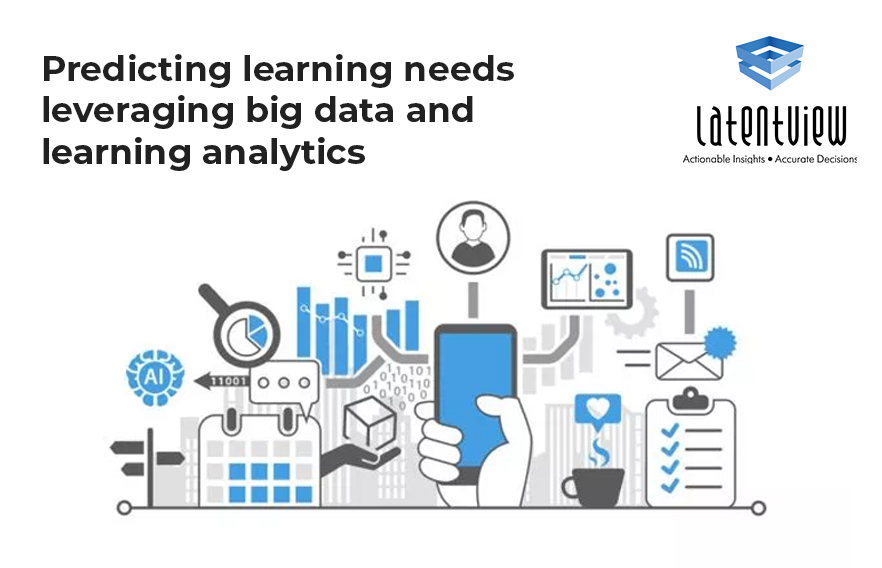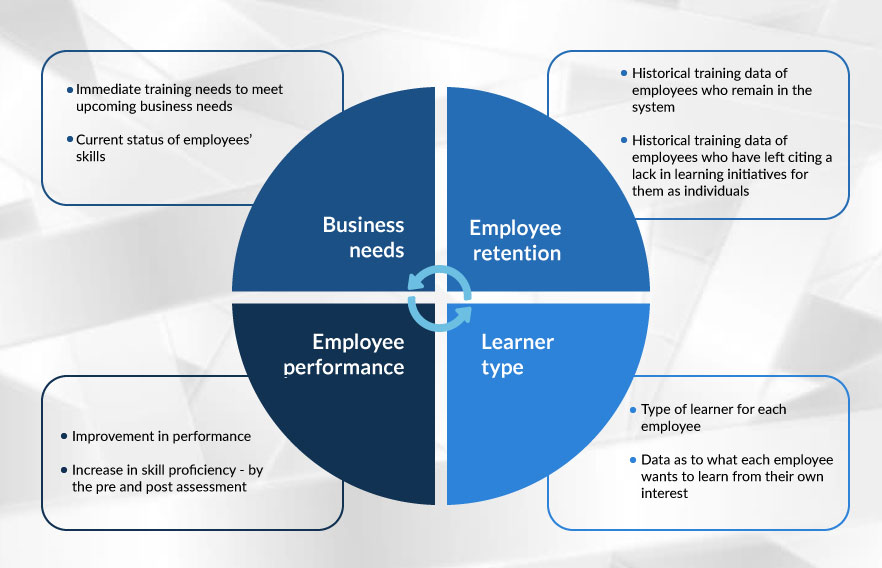Learning is an important piece of the puzzle for any organization’s success, yet its ROI is very perspective based. L&D professionals have been struggling for years to find a solid and reliable way to demonstrate ROI when it comes to learning initiatives. Leveraging the power of analytics, companies can understand the payback on learning and development initiatives more real-time, but what if we could flip the equation on its head? Can we use data and insights to predict future learning trends? Learning initiatives can be more pro-active by predicting training needs rather than re-active based on lost opportunities and revenue by utilizing AI in human resources. Let’s look at a few areas where this analysis can be performed:
1. Forthcoming business requirements
Another way to foresee training needs and learning trends is by simply understanding and collecting data on the details of future projects coming into the organization or understanding the growth potential of existing projects in terms of team size i.e. to assess the current skill level of employees who can move to a project against what skills the project requires. In a services organization like ours, where we work with multiple clients with a vast range of requirements, it is important to foresee these and plan to get the right talent with the right skills to meet client requirements efficiently.
Most organizations have data lying in silos – the project SOW, requirements and staffing document etc. In cases such as these, skill data can be collected using text analysis and while these may not be a 100% accurate, each team can validate this basis the work they do. This is measured against the current employee skills data. Sounds simple enough right? I’m sure most experienced L&D professionals will have a hundred arguments or comments to prove that this is not practical. Like, how do we know who will go to that project? Project dynamics keep changing, how do we keep up?
It is important to understand here that while we strive to give the business a perfect learning module there is only so much we can do. So, let’s restrict ourselves to the basic requirements and train employees on the basics required to kick off the work, and from there on they are on their own. Psychologically, people prefer to discover and learn on their own and we must give them that opportunity.
Now, what can we do?
First let’s understand the data available and how to collect it:
- Org skill matrix – readily available in most organizations. If not, this is a laundry list of the all the capabilities of employees rated against a scale to measure proficiency
- Project skills – as mentioned above, the skills required to perform a project or piece of work, it is important that we keep this to the basic skills required
- Resource forecast data – data on how many people are available, or prediction of how many will be available in a certain amount of time
Analysis
How do we piece all this together?
- No.1: Collate and understand the basic skills required for all upcoming work
- No.2: Which employees are available in the next two months? This is ample time for anyone to pick up a new skill or technology
- No. 3: What is their skill level?
Based on these numbers, the L&D team can devise the mode of training, duration of the learning intervention, when it is required and at what level of difficulty.
Data derived from this exercise:
- Immediate training needs to meet upcoming business needs
- Current status of employees’ skills
2. Do our learning initiatives affect performance?
Improving a technical skill or changing human behaviour in one training session is next to impossible. For the changes to reflect in the outcome or revenue will take time. So, we take certain business occasions to measure the intangible. The only way to link performance to training is measuring the effectiveness of the training. The effectiveness of a training can be measured using various data points, in which the participants’ performance is a major contributor. The effectiveness of a training can be particularly measured only by continuous monitoring at least three months post training.
Data that can be collected:
- Skill matrix – the repository of skills of all employees in the organization and their respective proficiency levels. Analyses on this data can give insights on what skill must be focused on and improved via training, and so the performance
- Assessment (Pre & Post training) – the same assessment gets administered twice, once before the training and once after the training to gauge the absorption of concepts from the training
- Follow-up assessment – a different assessment on the same skill will be administered one month after the training to understand the retention of learning
- Manager feedback – feedback from the manager to understand if the training has improved the individual’s performance
- Application of skills on the job – project success rate percentage
- Comparison between number of escalations due to gap in technical skills (Pre & Post training)
Analysis
The number of people who completed the training, the number of training man-hours and any amount of analytics on the same is not going to measure the effectiveness of the program.
The employee’s learning history throughout their tenure and the relation to other factors such as performance rating from PMS, HRMS, skill matrix portal, finance portal, project portal when connected in one analytics solution, will provide aligned data. This data can be compared at different time frames of the employee’s tenure to conclude whether the training has really addressed the challenge and translated to financial outcome.
Data derived from this exercise
- Percentage of employees with a marked improvement in performance
- Percentage of employees whose skill proficiency has increased
- Percentage of employees who have improved on that skill by the pre and post assessment
3. Does organized learning help retain employees?
Most companies do annual or bi-annual employee surveys and from a learning perspective this can be a crucial tool to understand not only the effectiveness of various learning initiatives, but also determine a pattern in employees that stay with the organization for a long period and also those that have left. This is a simple analysis that can be done i.e. by categorizing the answers to the following questions by the tenure of an employee and by those who have left the organization:
- “I have access to the learning and development I need to do my job well”
- “I believe there are good career opportunities for me at this company”
- “This is a great company that contributes to my development”
Employees do resign for various reasons other than training needs and skills development and yet in a research article by Glassdoor, states that, “Among millennials, the “ability to learn and progress” is now the principal driver of a company’s employment brand. Yet only one-third of millennials believe their organizations are using their skills well, and 42% say they are likely to leave because they are not learning fast enough.” Hence it makes sense to look at this data.
If the data shows a startling percentage of people leaving because of “un-met’’ training needs and not being able to develop any new skills while on the job, then it is obvious that we need to go back to the drawing board and strategize again.
Data derived from this exercise
- Historical training data of employees who remain in the system
- Historical training data of employees who have left citing a lack in learning initiatives for them as individuals
4. One size does not fit all
Any learning initiative starts with an objective in mind, i.e. increasing the proficiency level of a particular skill, technical or behavioural, from one level to another in a training or a series of training sessions. What makes it difficult is that the behavioural skills are not tangible, and we must create data points for it to be tangible.
All of it involves experimenting to find out what works – e-learning, classroom training, learning shots, self-learning. With the application of AI to predict the type of learner and match it to the mode of learning i.e. visual, auditory, and kinesthetic. The Learning Management System (LMS) in the organization can fetch results according the learning pattern, style, time and engagement on the platform. We could also learn from the various MOOC’s that use data from user search history to find out what learners are looking and if they find what they are looking for.
Types of learners
An automatic recommendation engine can be built for each learner that would collect the learning history by asking them a bunch of questions like:
- What are you looking at learning?
- How much time do you have?
- Do you do more hands-on work than managerial?
- What’s the best way for you to learn about how something works (like a computer or a/ video game)?
- What is the best way for you to remember a friend’s phone number?
This system should help them identify a course and a mode of learning best suited for their learning needs.
Data derived from this exercise
- Type of learner for each employee
- Data as to what each employee wants to learn from their own interest
Tying all these together would look something like this:
Organization Perspective
The data collected is from both a business perspective i.e. what the organization needs to grow and make revenue and from an employee perspective in terms of understanding what they need as individuals to perform. All these put together will help derive a successful learning strategy. The use of analytics to drive predictive learning will help organizations build a data-driven culture as it supports faster reportage, analysis and maximum use of current channels, building on what is known. Needless to say, the implementation of the same is a positive step forward and guarantees greater outcomes for all stakeholders. As years progress more data becomes available making the system more robust and accurate to make smarter and better business decisions.
Learning analytics to drive business performance
By leveraging to drive learning and development, organizations can understand how the learning organization is a vital cog when it comes to key business imperatives, that drive operational efficiency, boost employee performance and, most importantly, impact business outcomes. To understand how you can leverage learning analytics for your organization, write into: marketing@latentview.com





